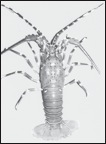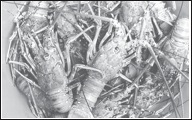
|
||||||||||||||||||||||||||||||||||||||||||||||||||||||||||||||||||||||||||||||||||||||||||||||||||||||||||||||||||||||||||||||||||||||||||||||||||||||||||||
| Fisheries :: Marine Cage | ||||||||||||||||||||||||||||||||||||||||||||||||||||||||||||||||||||||||||||||||||||||||||||||||||||||||||||||||||||||||||||||||||||||||||||||||||||||||||||
| |
||||||||||||||||||||||||||||||||||||||||||||||||||||||||||||||||||||||||||||||||||||||||||||||||||||||||||||||||||||||||||||||||||||||||||||||||||||||||||||
|
Lobster Farming Introduction Lobsters are high valued seafood with well established export markets around the world and form extremely important fisheries in many countries. Most world fisheries are either fully exploited, or overexploited. Annual landing of lobsters in India was 1539 t (2007), which averaged about 2200 t in 1990’s. Lobsters have excellent market demand and price and especially live lobsters are the most preferred. Annual export was to the tune of Rs.53 crores during 2003-04. Lobsters are exported in different forms; frozen tails, whole frozen, whole-chilled, whole-cooked and frozen, lobster meat and as in live form. Overseas customers are ready to pay more for fresh seafood. Live lobster export increased from 1.3% during 1993- 94 to 12.7% during 2003-04 periods. The high export demand has been a major economic benefit to the country. However, increased demand in the export market and high price led to over-harvesting employing destructive fishing practices. Degradation of natural habitats from pollution and human activities has contributed to a precipitous decline in the wild populations threatening the current market’s long-term sustainability. Conservation measures are not actively enforced by maritime states to prohibit harvesting of egg bearing females and juvenile lobsters. Government of India has implemented Minimum Legal Size (MLS) for export. Non-enforcement of regulations has led to illegal export of juveniles and undersize lobsters. Undersize lobsters fetch very low price and if fattened to commercial grade can fetch higher price and can be exported legally. Therefore, fattening of low value lobsters with a view to value addition is a possibility. CMFRI has developed technology for semi-commercial scale culture of lobsters in land-based tanks. There were also attempts to culture lobsters in small nearshore fixed cages. Attempts are now in progress to farm lobsters in large marine cages by CMFRI. A major stumbling block, however, in realizing the aquaculture potential has been the difficulties of rearing the larvae through their long and complex larval stages. Although some species have been successfully reared to settlement, large scale production of seed lobsters has not yet been possible. Successful application of the hatchery technologies seems to be far away due to obvious reasons. Taxonomy
Distribution of spiny lobsters along the Indian coast Although the lobster fauna of India comprises 25 species), only four littoral and one deep sea form contribute to commercial fishery. The northwest coast fishery is mainly constituted by the spiny lobster Panulirus polyphagus (mud spiny lobster) and the slipper lobster Thenus sp. (shovel-nosed lobster) (which inhabit at 20-50 m depth. The shallow water P. homarus homarus (scalloped spiny lobster) occupying 1-20 m depth range is the most dominant species along the southwest coast, whereas P. ornatus (ornate spiny lobster) P. homarus homarus and Thenus spp. contribute to the fishery on the southeast coast. Small quantities of P. versicolor are also landed along the Trivandrum and Chennai coasts. P. penicillatus and P. longipes are the two other species, which are not important from the fishery point of view. Adult P.ornatus inhabits relatively deeper areas (40-50 m). The spiny lobster Puerulus sewelli occupy the upper continental slope between 175-200 m depth off the southwest and southeast coasts from where they are fished along with deepsea shrimps by trawlers Linupurus somniosus is another species of spiny lobster recorded from the Andaman waters. P. polyphagus is called Titan in Gujarathi, Shevand in Marathi, Chittakonju/Kadal konchu in Malayalam and Katearatioroyya in Telugu, P. homarus is called Thala eral in Tamil and Bama reya in Telugu. The vernacular name of P. ornatus is Mani eral in Tamil. In the export trade P. ornatus is commonly known as tiger and others as Greens.
Farming potential of spiny lobsters Limited availability, high consumer demand and high market value has driven interest in both experimental and commercial farming of spiny lobsters worldwide. There has been considerable interest in developing culture technologies for the 47 species in this family. Previous studies have shown that tropical species are more promising for commercial production due to fast growth rate and good consumer demand. In India three species are most suitable for farming: P. homarus homarus of southwest and southeast coast, P. polyphagus of north west coast and P. ornatus of southeast coast. Hatchery based farming of spiny lobsters is technically possible but not economically feasible due to difficulties in producing large numbers of puerulii through larval rearing techniques. Though some species have been successfully reared through their larval life , due to prolonged larval phase and difficulties in rearing large numbers, successful commercial application seems to be far away. The recent advances in larval rearing and the management strategies required for procurement and transportation of incidental catches of juveniles lobsters, which could form a good seed base for lobster farming is discussed. |
||||||||||||||||||||||||||||||||||||||||||||||||||||||||||||||||||||||||||||||||||||||||||||||||||||||||||||||||||||||||||||||||||||||||||||||||||||||||||||
© All Rights Reserved. TNAU 2009-15. |
||||||||||||||||||||||||||||||||||||||||||||||||||||||||||||||||||||||||||||||||||||||||||||||||||||||||||||||||||||||||||||||||||||||||||||||||||||||||||||






